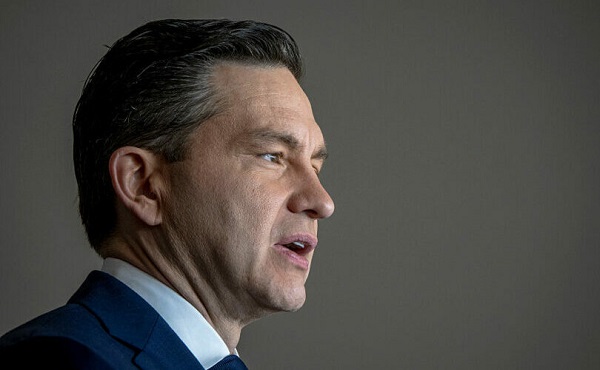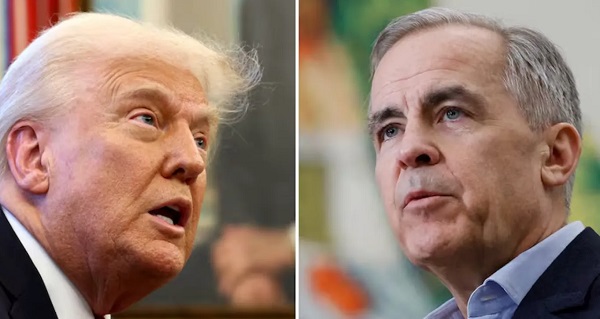Opinion
British Columbia city defends allowing grown man to change in front of girls

From LifeSiteNews
The City of Vernon, British Columbia, is defending a pool manager’s decision to allow a grown man to change in the presence of teenage girls under the pretense that prohibiting such behavior is a violation of federal law.
An average news day in Canada, circa 2024, in Vernon, British Columbia:
Two teenage girls going through the lifeguarding program at the Vernon Aquatic Centre were shocked to be changing beside a person they soon found out had a penis. It was the last Saturday in January and the girls wasted no time in telling their families what they had just experienced.
‘My niece had a 50-year-old man come into the change room, strip naked in front of her and her friend, she’s 14, and put on a woman’s bathing suit and go out.’
The pool manager was contacted. “He basically said the kids have no rights and that the transgender person’s rights take precedence, this is something I think parents should know,” said the girls’ uncle, who asked to be quoted only by his first name, Kevin, for privacy purposes. According to management, to forbid a middle-aged trans-identified man from stripping naked next to young teenage girls would be a violation of Prime Minister Justin Trudeau’s Bill C-16, which forbids discrimination on the basis of “gender identity and gender expression.”
Carolyn Baldridge, a spokeswoman for the City of Vernon, told the press that this was in line with the law. “It is against the law for Vernon Recreation staff to dictate what washroom/change room that a customer can use based on their appearance,” she said. “Staff cannot ask someone to leave for changing in the change room of their choice.” Since the passage of Bill C-16, the Vernon Aquatic Centre changed its “Family Change room” sign to “Universal change room,” meaning that the nude guy was well within his rights to do what he did.
“Under Canadian law, users are free to change in the room that they best identify with,” Baldridge added, noting that “inclusive recreation” is an “evolving discussion across Canada” and that “Vernon’s Recreation Services will continue to take steps to ensure the inclusion of gender diverse Canadians in their programs and facilities.”
According to Kevin: “I was told by the pool manager that there was nothing he could do unless the person was ‘leering or making overt sexual gestures toward the girls’ but this guy was naked in front of teenage girls and that’s just not right.” Kevin is right; the law is wrong; the privacy of young girls is collateral damage, although the Vernon North Okanagan RCMP stated that if anything inappropriate—besides the full-frontal nudity in front of young teen girls, that is—occurred, that they would be willing to investigate.
There are plenty of LGBT activists who get upset at those of us who point out how disgusting this state of affairs is, insisting that we are fearmongering or smearing people. But it needs to be said: a man who is willing to expose himself in front of teenage girls, regardless of whether or not he truly believes himself to be a woman, should not be trusted, full stop. There are private stalls available that he could have used. Unless he is unfathomably stupid, he knew that doing what he was doing could make the girls scared, uncomfortable, or insecure—and he chose to do it anyway.
The sincerity of his gender dysphoria is really besides the point here. These men are willing to make young girls fearful in order to live their preferred identities in public because they simply do not care—and many, it seems, take a perverse pleasure in forcing everyone to play along. There is a vindictiveness about this that should be pointed out. Any man, deluded or not, who is unwilling to consider how his behavior might make more vulnerable people feel is simply not worthy of respect.
Author
Business
It Took Trump To Get Canada Serious About Free Trade With Itself

From the Frontier Centre for Public Policy
By Lee Harding
Trump’s protectionism has jolted Canada into finally beginning to tear down interprovincial trade barriers
The threat of Donald Trump’s tariffs and the potential collapse of North American free trade have prompted Canada to look inward. With international trade under pressure, the country is—at last—taking meaningful steps to improve trade within its borders.
Canada’s Constitution gives provinces control over many key economic levers. While Ottawa manages international trade, the provinces regulate licensing, certification and procurement rules. These fragmented regulations have long acted as internal trade barriers, forcing companies and professionals to navigate duplicate approval processes when operating across provincial lines.
These restrictions increase costs, delay projects and limit job opportunities for businesses and workers. For consumers, they mean higher prices and fewer choices. Economists estimate that these barriers hold back up to $200 billion of Canada’s economy annually, roughly eight per cent of the country’s GDP.
Ironically, it wasn’t until after Canada signed the North American Free Trade Agreement that it began to address domestic trade restrictions. In 1994, the first ministers signed the Agreement on Internal Trade (AIT), committing to equal treatment of bidders on provincial and municipal contracts. Subsequent regional agreements, such as Alberta and British Columbia’s Trade, Investment and Labour Mobility Agreement in 2007, and the New West Partnership that followed, expanded cooperation to include broader credential recognition and enforceable dispute resolution.
In 2017, the Canadian Free Trade Agreement (CFTA) replaced the AIT to streamline trade among provinces and territories. While more ambitious in scope, the CFTA’s effectiveness has been limited by a patchwork of exemptions and slow implementation.
Now, however, Trump’s protectionism has reignited momentum to fix the problem. In recent months, provincial and territorial labour market ministers met with their federal counterpart to strengthen the CFTA. Their goal: to remove longstanding barriers and unlock the full potential of Canada’s internal market.
According to a March 5 CFTA press release, five governments have agreed to eliminate 40 exemptions they previously claimed for themselves. A June 1 deadline has been set to produce an action plan for nationwide mutual recognition of professional credentials. Ministers are also working on the mutual recognition of consumer goods, excluding food, so that if a product is approved for sale in one province, it can be sold anywhere in Canada without added red tape.
Ontario Premier Doug Ford has signalled that his province won’t wait for consensus. Ontario is dropping all its CFTA exemptions, allowing medical professionals to begin practising while awaiting registration with provincial regulators.
Ontario has partnered with Nova Scotia and New Brunswick to implement mutual recognition of goods, services and registered workers. These provinces have also enabled direct-to-consumer alcohol sales, letting individuals purchase alcohol directly from producers for personal consumption.
A joint CFTA statement says other provinces intend to follow suit, except Prince Edward Island and Newfoundland and Labrador.
These developments are long overdue. Confederation happened more than 150 years ago, and prohibition ended more than a century ago, yet Canadians still face barriers when trying to buy a bottle of wine from another province or find work across a provincial line.
Perhaps now, Canada will finally become the economic union it was always meant to be. Few would thank Donald Trump, but without his tariffs, this renewed urgency to break down internal trade barriers might never have emerged.
Lee Harding is a research fellow with the Frontier Centre for Public Policy.
Alberta
Governments in Alberta should spur homebuilding amid population explosion

From the Fraser Institute
By Tegan Hill and Austin Thompson
In 2024, construction started on 47,827 housing units—the most since 48,336 units in 2007 when population growth was less than half of what it was in 2024.
Alberta has long been viewed as an oasis in Canada’s overheated housing market—a refuge for Canadians priced out of high-cost centres such as Vancouver and Toronto. But the oasis is starting to dry up. House prices and rents in the province have spiked by about one-third since the start of the pandemic. According to a recent Maru poll, more than 70 per cent of Calgarians and Edmontonians doubt they will ever be able to afford a home in their city. Which raises the question: how much longer can this go on?
Alberta’s housing affordability problem reflects a simple reality—not enough homes have been built to accommodate the province’s growing population. The result? More Albertans competing for the same homes and rental units, pushing prices higher.
Population growth has always been volatile in Alberta, but the recent surge, fuelled by record levels of immigration, is unprecedented. Alberta has set new population growth records every year since 2022, culminating in the largest-ever increase of 186,704 new residents in 2024—nearly 70 per cent more than the largest pre-pandemic increase in 2013.
Homebuilding has increased, but not enough to keep pace with the rise in population. In 2024, construction started on 47,827 housing units—the most since 48,336 units in 2007 when population growth was less than half of what it was in 2024.
Moreover, from 1972 to 2019, Alberta added 2.1 new residents (on average) for every housing unit started compared to 3.9 new residents for every housing unit started in 2024. Put differently, today nearly twice as many new residents are potentially competing for each new home compared to historical norms.
While Alberta attracts more Canadians from other provinces than any other province, federal immigration and residency policies drive Alberta’s population growth. So while the provincial government has little control over its population growth, provincial and municipal governments can affect the pace of homebuilding.
For example, recent provincial amendments to the city charters in Calgary and Edmonton have helped standardize building codes, which should minimize cost and complexity for builders who operate across different jurisdictions. Municipal zoning reforms in Calgary, Edmonton and Red Deer have made it easier to build higher-density housing, and Lethbridge and Medicine Hat may soon follow suit. These changes should make it easier and faster to build homes, helping Alberta maintain some of the least restrictive building rules and quickest approval timelines in Canada.
There is, however, room for improvement. Policymakers at both the provincial and municipal level should streamline rules for building, reduce regulatory uncertainty and development costs, and shorten timelines for permit approvals. Calgary, for instance, imposes fees on developers to fund a wide array of public infrastructure—including roads, sewers, libraries, even buses—while Edmonton currently only imposes fees to fund the construction of new firehalls.
It’s difficult to say how long Alberta’s housing affordability woes will endure, but the situation is unlikely to improve unless homebuilding increases, spurred by government policies that facilitate more development.
-

 2025 Federal Election5 hours ago
2025 Federal Election5 hours agoThe Federal Brief That Should Sink Carney
-

 2025 Federal Election7 hours ago
2025 Federal Election7 hours agoHow Canada’s Mainstream Media Lost the Public Trust
-

 2025 Federal Election10 hours ago
2025 Federal Election10 hours agoOttawa Confirms China interfering with 2025 federal election: Beijing Seeks to Block Joe Tay’s Election
-

 2025 Federal Election9 hours ago
2025 Federal Election9 hours agoReal Homes vs. Modular Shoeboxes: The Housing Battle Between Poilievre and Carney
-

 John Stossel6 hours ago
John Stossel6 hours agoClimate Change Myths Part 2: Wildfires, Drought, Rising Sea Level, and Coral Reefs
-

 COVID-198 hours ago
COVID-198 hours agoNearly Half of “COVID-19 Deaths” Were Not Due to COVID-19 – Scientific Reports Journal
-

 2025 Federal Election2 days ago
2025 Federal Election2 days agoPoilievre’s Conservatives promise to repeal policy allowing male criminals in female jails
-

 2025 Federal Election2 days ago
2025 Federal Election2 days agoCarney Liberals pledge to follow ‘gender-based goals analysis’ in all government policy




